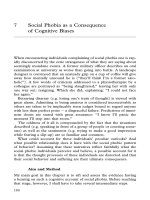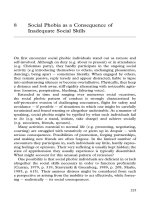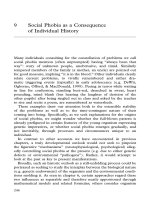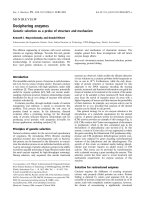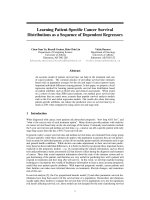ACQUIRED STAT4 DEFICIENCY AS A CONSEQUENCE OF CANCER CHEMOTHERAPY
Bạn đang xem bản rút gọn của tài liệu. Xem và tải ngay bản đầy đủ của tài liệu tại đây (1.09 MB, 101 trang )
Graduate School ETD Form 9
(Revised 12/07)
PURDUE UNIVERSITY
GRADUATE SCHOOL
Thesis/Dissertation Acceptance
This is to certify that the thesis/dissertation prepared
By
Entitled
For the degree of
Is approved by the final examining committee:
Chair
To the best of my knowledge and as understood by the student in the Research Integrity and
Copyright Disclaimer (Graduate School Form 20), this thesis/dissertation adheres to the provisions of
Purdue University’s “Policy on Integrity in Research” and the use of copyrighted material.
Approved by Major Professor(s): ____________________________________
____________________________________
Approved by:
Head of the Graduate Program Date
Ivan Lupov
"ACQUIRED STAT4 DEFICIENCY AS A CONSEQUENCE OF CANCER CHEMOTHERAPY"
Master of Science
Hua-Chen Chang
Stephen Randall
Michael Robertson
Hua-Chen Chang
Simon Atkinson
4/15/2011
Graduate School Form 20
(Revised 9/10)
PURDUE UNIVERSITY
GRADUATE SCHOOL
Research Integrity and Copyright Disclaimer
Title of Thesis/Dissertation:
For the degree of
Choose your degree
I certify that in the preparation of this thesis, I have observed the provisions of Purdue University
Executive Memorandum No. C-22, September 6, 1991, Policy on Integrity in Research.*
Further, I certify that this work is free of plagiarism and all materials appearing in this
thesis/dissertation have been properly quoted and attributed.
I certify that all copyrighted material incorporated into this thesis/dissertation is in compliance with the
United States’ copyright law and that I have received written permission from the copyright owners for
my use of their work, which is beyond the scope of the law. I agree to indemnify and save harmless
Purdue University from any and all claims that may be asserted or that may arise from any copyright
violation.
______________________________________
Printed Name and Signature of Candidate
______________________________________
Date (month/day/year)
*Located at />"ACQUIRED STAT4 DEFICIENCY AS A CONSEQUENCE OF CANCER CHEMOTHERAPY"
Master of Science
Ivan Lupov
4/15/2011
ACQUIRED STAT4 DEFICIENCY AS A CONSEQUENCE OF
CANCER CHEMOTHERAPY
A Thesis
Submitted to the Faculty
of
Purdue University
by
Ivan Lupov
In Partial Fulfillment of the
Requirements for the Degree
of
Master of Science
May 2011
Purdue University
Indianapolis, Indiana
ii
ACKNOWLEDGMENTS
I would like to thank Dr. Hua-Chen Chang for accepting me in her lab. She has
fully equipped me with the skills I will need to succeed in my future training as a
scientist. I would also like to thank Dr. Stephen Randall for challenging me intellectually,
inside and outside lecture hall, Dr. Michael Robertson for his instrumental support and
mentorship throughout the completion of this project and of course, the wonderful and
irreplaceable technician Ling Han.
iii
TABLE OF CONTENTS
Page
LIST OF FIGURES vi
LIST OF ABBREVIATIONS viii
ABSTRACT x
CHAPTER 1. LITERATURE REVIEW 1
1.1. STAT4 Structure and Expression 2
1.2. Mechanisms of STAT4 regulation 6
1.3. STAT4 Activation and Signal Transduction 10
1.4. STAT4 Translocation 11
1.5. Mechanism of Gene Regultion by STAT4 12
1.6. Roles of STAT4 in Diseases 15
1.7. Summary 18
CHAPTER 2. MATERIALS AND METHODS 19
2.1. Blood Samples, Cell Cultures, and Cell Lines 19
2.2. Cytokines, Antibodies, Chemotherapy Drugs, and Other Reagents 20
2.3. Analysis of STAT4 Protein and RNA Levels 20
2.4. Analysis of Differential Cell Type Proliferation in Response toIn vitro
Stimulation 21
iv
Page
2.5. Assessment of STAT4 mRNA and Protein Half-life 21
2.6. Immunoprecipitation and Analysis of Ubiquitin-conjugated STAT4 Protein 22
2.7. Evaluation of IFN-γ Production 22
2.8. Gene Expression of STAT4 Isoforms 22
2.9. STAT4 Expression in Murine NK Cells 23
2.10. Statistical Analysis 24
CHAPTER 3.ACQUIRED STAT4 DEFICIENCY AS A CONSEQUENCE OF
CANCER CHEMOTHERAPY 25
3.1. Introduction 25
3.2. Results 27
3.2.1. STAT4 Deficiency is a Consequence of Chemotherapy Treatment and
is Not Due to Lymphoma Tumor Burden 27
3.2.2. Acquired STAT4 Deficiency of Normal PBMCs Treated In vitro
With Chemotherapy Drugs 28
3.2.3. STAT4 mRNA Stability is Not Affected by Chemotherapy 30
3.2.4. Ubiquitin-mediated Proteasomal Degradation of STAT4 in
Chemotherapy-Treated Cells 31
3.3. Discussion 33
3.4. Future Directions 37
BIBLIOGRAPHY 54
v
Page
APPENDICES
Appendix A 72
Appendix B. 75
Appendix C. 80
vi
LIST OF FIGURES
Figure Page
Figure 1. General information about the STAT4 signaling pathway and
the specific structure of both STAT4 isoforms 39
Figure 2. Expression of STAT4 in PBMCs obtained from lymphoma patients
before chemotherapy. 40
Figure 3. Expression of STAT4 in PBMCs obtained from lymphoma patients
after standard dose of chemotherapy. 41
Figure 4. Expression of STAT4 in PBMCs obtained from lymphoma patients
after high dose chemotherapy 42
Figure 5. Expression of STAT4 in cells treated in vitro with chemotherapeutic
drugs associated with high dose treatment 43
Figure 6. Effects on mouse STAT4 protein expression as a result of chemotherapy
treatment 44
Figure 7. Expression of STAT4 among different T lymphocytes after in vitro with
chemotherapeutic drugs 45
Figure 8. Relative amounts of different cell types after in vitro stimulation
with IL2 and PHA of PBMCs from healthy individuals 46
Figure 9. Effects of in vitro chemotherapy treatment on NK cell population 47
Figure 10. STAT4 mRNA levels and half-life of STAT4 mRNA in PBMCs 48
Figure 11. Analysis of methylation based regulation of STAT4 via
5-Azacitidne treatment 49
Figure 12. Chemotherapy drugs reduce STAT4 protein half-life 50
Figure 13. Ubiquitin-mediated proteasomal degradation as the cause of
chemotherapy induced STAT4 deficiency 51
vii
Figure Page
Figure 14. Rescuing the levels of STAT4 via inhibition of the
proteasome machinery 52
Figure 15. Restoring IFNγ secretion in post chemotherapy treated cells with
Bortezomib treatment 53
Appendix A
Figure Page
Figure A1. Expression of STAT4α and STAT4β isoforms in the NK cells
from STAT4 transgenic mice 72
Figure A2. Detecting STAT4 isoform transcripts in human PBMCs 73
Figure A3. Calculating STAT4 protein half-life using the NIH ImageJ program 74
Appendix B
Figure B1. Primer sequences for analyzing gene expression of STAT4α isoform 75
Appendix C
Figure C1. Primer sequences for analyzing gene expression of STAT4β isoform 80
viii
LIST OF ABBREVIATIONS
-D No drug Added
C Control cells from normal PBMCs
CC Coiled-coiled domain
CAR Carmustine
CD4+ Marker for T helper type I lymphocytes (also abbreviated Th1)
CD8+ Marker for CTL
CD56+ Marker for NK cells
ChiP Chromatin immunoprecipitation experiment
CVB3 Coxsackievirus B3
CTL Cytotoxic T Lymphocyte
DBD DNA binding domain
DC Dendritic Cells
EAE Experimental autoimmune encephalomyelitis
ETO Etoposide
Hlx Homeobox protein HB24 – transcription factor in activated lymphocytes
IFNα Interferon alpha
IFNγ Interferon gamma
IL Interleukin
IL#R Interleukin # Receptor
ISG Interferon Stimulated Gene – ubiquitin-like protein (same as ISG15)
JAK Janus Associated Kinase
ix
LK Linker domain
LPS Lipopolysaccharide
P Patient cells
P#H Particular patient after high dose of chemotherapy treatment
pY Phosphorylated form of the amino acid tyrosine
pS Phosphorylated form of the amino acid serine
PBMC Peripheral Blood Mononuclear Cells
PIAS Protein Inhibitors of Activated STATs
MHC Major Histocompatibility Complex (Type I or Type II)
MS Multiple sclerosis
NK Natural Killer Cells (see also CD56+)
RA Rheumatoid Arthritis
RT-PCR Real Time Polymerase Chain Reaction
S Standard Dose Chemotherapy
SLE Systemic lupus erythematosus
SLIM STAT-interacting, LIM domain processing protein
STAT Signal Transducer and Activator of Transcription
SOCS Suppressors Of Cytokine Signaling
SUMO Ubiquitin-like molecule that modifies proteins
TAD Transcriptional activation domain
TC45 Nuclear phosphatase involved in deactivating STAT1
Th1 See CD4+
Y Designates the amino acid tyrosine
x
ABSTRACT
Lupov, Ivan M.S., Purdue University, May 2011. Acquired STAT4 deficiency as a
consequence of cancer chemotherapy. Major Professor: Hua-Chen Chang.
Signal Transducer and Activator of Transcription 4 (STAT4) is an important
transcription factor activated by IL-12 signaling. Activated STAT4 is essential for Th1
cell differentiation, a process characterized by increased potential for interferon (IFN)-γ
production. Defective IFN-γ production due to STAT4 deficiency occurs after autologous
stem cell transplantation for lymphoma.
We have investigated the mechanisms of post-transplant STAT4 deficiency. The
tumor-bearing state is ruled out to be the cause because STAT4 levels were not
significantly different in peripheral blood mononuclear cells (PBMCs) obtained from
lymphoma patients prior to treatment and healthy control subjects. The magnitude of the
decrease in STAT4 levels corresponded with increasing intensity of chemotherapeutic
treatment in vivo. Furthermore, treatment of normal PBMC cultures or a natural killer
(NK) cell line with chemotherapy drugs in vitro also resulted in reduced STAT4 protein
and reduced IL-12-induced IFN-γ production. Chemotherapy drugs are shown to have no
impact on the stability of STAT4 mRNA, while steady-state levels of STAT4transcripts
are decreased in lymphoma patients.
xi
Our findings demonstrated that chemotherapeutic drugs up-regulate the
ubiquitination rates of the STAT4 protein, which in turn promotes its degradation via the
proteasome-mediated pathway. Treatment with the proteasome inhibitor bortezomib
largely reversed the chemotherapy-induced STAT4 deficiency. Thus, acquired STAT4
deficiency in lymphoma patients is a consequence of treatment with chemotherapy. These
results have important implications for design of optimal immunotherapy for lymphoma.
1
CHAPTER 1. LITERATURE REVIEW
The purpose of this literature review is to provide an overarching background on
what has been discovered about the structure and function of the transcription factor
called Signal Transducer and Activator of Transcription 4 (STAT4). The information will
demonstrate the ever expanding breath of knowledge about the mechanism by which
STAT4 brings changes to the repertoire of an entire cell – modulating the expression of a
wide rage of genes and in the process driving the systematic differentiation of what’s
commonly known as T-helper 1 (Th1) cells. Th1 cells are crucial in mounting a proper
immune response to a variety of intracellular pathogens and viruses, as well as
contributing to the tumor surveillance by the immune system. Gaining greater
understanding of what is the molecular structure and function of STAT4, how is it
activated and its’ function regulated will help us understand the importance of its’
biological function. Furthermore, this information will help emphasize the significance of
STAT4 deficiency not only for lymphoma patients, which are the object of our study, but
for the ability to have a proper functional immune system in general.
STAT4 is member of a family of transcription factors that are commonly referred
to as STATs(1-4). Initially, about two decades ago, what piqued the scientific
community’s interest in these transcription factors was their specific response to various
extracellular signals and most importantly their direct impact on gene expression that
2
circumvented the need for secondary messengers. Currently, there are 7 known members
of the STAT family that serve distinct biological functions from development to
immunity(5-8).
1.1.
a. Structure
STAT4 Structure and Expression
STAT4 shares a well conserved protein structure with the rest of the STAT family
transcription factors. There are 6 distinct domains (Figure 1C) – N-terminal (NH
2
5
),
coiled-coil (CC), DNA binding (DBD), linker (LK), SH2, tyrosine activation (Y) and
transcriptional activation domain (TAD) ( , 6). Each one of these domains has distinct
role in the overall function of each STAT molecule. In order to understand the specific
role of each one of these, it is important to delineate the main steps in STAT4 activation
and signaling, while leaving the details of the pathway to the following section of the
paper.
In general, all STAT molecules are found latent in the cytoplasm (Figure 1A).
When outside signaling molecule (ex: IL-12) binds to a transmembrane receptor (IL-12R)
it induces a conformational change that allows the recruitment of the Janus family of
receptor associated kinases or JAKs. In turn, these JAK kinases phosphorylate the
receptor making it a docking site for a STAT molecule (STAT4 in the case of IL-12
stimulation) (Figure 1A). When the respective STAT binds to the phosphorylated part of
the receptor, it becomes, in turn, phosphorylated and thus activated. It gets released from
the docking site and forms a homodimer with another activated STAT molecule(4).
3
These partnering transcription factors then migrate to the nucleus where they either
activate transcription of genes or they form heterodimers with other activated STATs
allowing for greater variability in the DNA binding capability(Figure 1A)(9).
It has been previously reported that the N-terminus of STAT4 consists of the first
123 amino acids of the overall 748 amino acid long protein sequence (Figure 1B). The
amino acids of N-terminus are said to come together and form a hook-like structure (10,
11). This structure has been reported as crucial in 2 key functional characteristics of
STAT4 – it is needed for the IL-12 receptor mediated phosphorylation and for allowing
cooperative binding to DNA sequences in association with other activated forms of
STATs (12, 13). Recently, researchers have challenged the commonly accepted model of
STAT activation by showing that STAT1 and STAT4 can form homodimers prior to
activation and that the N-terminal domain is essential for the process (14, 15).
These findings about the function of the N-terminus demonstrate a rather
prevalent issue within the STAT research field. Investigators have often taken the high
level of homology among the STAT family members as an indicator of similarity in
function. There is mounting evidence, as will be indicated later in this review,
emphasizing the need to consider the potential existence of much greater specificity than
has previously been envisioned (16, 17).
The C-terminal domains of all STATs contain three individually characterized
segments – SH2, tyrosine activation (Y) and transcriptional activation domains
(TAD)(Figure 1B). The SH2 domain of all STATs is important for allowing binding to
the JAK-tyrosine (Y) phosphorylated receptor. When the respective JAK, in turn,
4
phosphorylates the receptor associated STAT molecule, then the SH2 domain functions
in driving the reciprocal homo or hetero dimerization of the STATs. Thus, each partner
docks to the other partner’s phosphorylated site via their respective SH2 domains. (18)
In order for STAT4 to get activated, released and partnered with another STAT4
molecule it first has to be phosphorylated on the 693
rd
19
tyrosine residue of its protein
sequence (Figure 1B)( ). Furthermore, STAT4, like other STAT members, can also be
phosphorylated on the 721
st
20
serine amino acid residue via the activation of the p38/MKK
pathway (Figure 1B) ( ). This has been shown to be complementing the full
transcriptional activity of activated STAT4, that is in addition to the effects of the IL-12
receptor mediated signaling pathway. (20-23).
The third domain that is located within the C-terminus of all STAT molecules is
the transcriptional activation domain (TAD). Beyond its ostensible role in activating gene
expression, it’s the site of alternative splicing that leads to formation of different
isoforms. By convention, the full protein structure is referred to as α, while the shorter
spliced isoforms are termed β. Currently, the isoforms of STAT1,3, 4 and 5 have been
sequenced and their function elucidated (2, 7, 24-26). The functional characteristics of
STAT4β isoform have generated interesting variations in activation and function. So far
the STAT4β has been shown to be phosphorylated and thus activated in response to
growth hormones like estrogen (27). STAT4β has also been shown to differ from its
alpha isoform by the number of genes that it activates. There are 29 unique genes
activated by the beta isoform that are not activated by the alpha form, thus demonstrating
their inherent capability of mediating IL-12 responses differently (7).
5
So far, the coiled-coil (CC) domain of STATs (Figure 1B) does not have a clearly
defined functional characteristic. The evidence has pointed in the direction of it playing a
role in either regulating protein half-life independent of the proteasome (28), interacting
with other non-STAT transcription factors (29), mediating the receptor binding and
subsequent activation (30), or aiding with the nuclear transport of the activated form (31).
All of these findings have been reported after extensive investigation of either STAT 1, 2
or 3 but not STAT4.
b. Cellular and Tissue Expression of STAT4
STAT4, unlike other transcription factors such as STAT3, is expressed
predominantly within the hematopoietic lineage (32, 33). Within the lymphoid branch of
the hematopoietic cells, STAT4 is expressed in Th1, CTL and NK cells (19, 34, 35).
Within Th1 type, STAT4 is required for the proper cellular differentiation - as the lack of
either IL-12R or STAT4 results in the loss of Th1 phenotype, traditionally associated
with reduced IFNγ secretion (34-37). Even though, the evidence has firmly established
the aforementioned paradigm, researchers have also shown the presence of a STAT4
independent pathway that leads to a proper development of Th1 cells (38).
A significant portion of the initial research focused on the role of STAT4 in T and
NK cells alone, while recent findings have shown that STAT4 is expressed in activated
monocytes (activated by LPS or IFNγ), mature dendritic cells (DC), connective tissue-
type mast cells, and B cells – three of which belong to the myeloid lineage (except B
6
cells)(39-42). In activated monocytes and mature DC, STAT4 is activated not by IL-12,
as is the case with Th1 and NK cells, but by IFNα and other cytokines (39, 43).
Going beyond hematopoietic cell lineage, STAT4 expression has also been
confirmed in the testis (33) as well as human vascular endothelial cells and human
vascular smooth muscle cells (44-47). Researchers have made interesting headway in
elucidating the mechanism by which STAT4 expression in vascular endothelial cells
might guide an inflammatory response (44).
1.2.
As the importance of proper cytokine signaling continues to be revealed, ever
greater information surfaces about the regulatory mechanism that keeps the process under
strict control. Because Th1 cells need to mount a quick response to stimuli like IL-12,
different pathways must be in place to limit the impact and prevent exaggerated outcome,
which is equally damaging to the propriety of the immune response.
Mechanisms of STAT4 regulation
There are two known mechanisms regulating transcriptional expression of STAT4
– epigenetic control or regulation by other transcription factors. The epigenetic control of
STAT4 transcription has been linked to the DNA methylation levels of its promoter,
where hypermethylation has an inhibitory role, while hypomethylation has the opposite
effect (48). In T cells, STAT4 expression is reported to be under the control of the
transcription factor Ikaros, while in DCs the expression is controlled by the activity of
NF-κB and AP-1, which are also transcription factors (43, 49).
7
There are 4 known players that have been implicated in the control of STAT4
protein activity – PIASx, SLIM, SOCS3 and Hlx. Prior to explaining the function of each
regulatory modulator, it is essential to point out that in order to fulfill their role as STAT4
regulators (with the exception of Hlx) there needs to be a specific post-translation
modification of the STAT4 protein. The three main types of modifications that have been
linked to the JAK/STAT pathway are ubiquitination, sumoylation (SUMO), and
ISGylation (ISG15) (50-52).
Regardless of the difference in terminology, all three follow a pathway that’s very
similar to the traditionally established ubiquitin mediated proteasome degradation –
where an E1 enzyme binds to an ubiquitin molecule and transfers it to an E2 conjugating
enzyme. The substrate specificity always comes from the E3 enzyme that recognizes its
target and facilitates the ubiquitin transfer from the E2 to the target. Once ubiquitinated,
the target is destined for degradation through the 26S proteasome (53). Ubiquitination has
been long implicated in the regulation of JAK/STAT pathway – as early as few years
after the initial discovery and even though research has grown tremendously in this area,
much more remains (54).
Protein-inhibitors of activated STATs (PIAS) were initially discovered at a time
when the information about the importance of STAT1 signaling was rapidly growing
while the knowledge of its regulation was completely missing (55). There are four
members of the PIAS family that are currently recognized – PIAS1, PIAS3, PIASy and
PIASx. Co-immunoprecipitation experiments have confirmed that three of the PIAS
inhibitors have specific STAT partners – PAIS1 pairs with STAT1, PIAS3 with STAT3,
8
and PIASx with STAT4 (56-58). Even thought PIAS inhibitors possess the ability to
directly modify their targets by sumoylation, the full function of PIASx has been shown
to depend on the recruitment of yet unknown deacetylase (58-60).
SLIM (or STAT-interacting LIM domain possessing protein) is the direct link
between ubiquitin-mediated proteasome degradation and the total STAT4 protein levels.
It has been shown that SLIM is an ubiquitin E3 ligase that specifically marks STAT1 and
STAT4 for proteasome degradation (61). This was further verified by the phenotype of
SLIM deficient mice, which had greater levels of STAT1 and STAT4 correlating with
greater IFNγ secretion (61). Tanaka et al have also shown that in addition to the
aforementioned function, SLIM might be involved in inhibiting STAT4 tyrosine
phosphorylation via recruitment of yet unidentified adaptor molecule (61). Furthermore,
the researchers do not dismiss the idea of SLIM as a monoubiquitin modifier that
bypasses the proteasome and instead serves as a localization signal (61). Regardless of
the limited evidence in favor of STAT specific E3 ligases, evidence implicating the
proteasome in regulating either total or activated STATs have been mounting (62, 63).
All of these scenarios provide an exciting future in understanding the role of
ubiquitination in JAK/STAT signaling.
Suppressors of cytokine signaling (SOCS) are the most extensively studied group
of proteins that are involved in regulating JAK/STAT signaling (64). Their expression is
typically minimal unless the cells are stimulated with specific cytokines(65). Increase in
expression eventually leads to deactivating the cytokine stimulated signaling. There are
numerous mechanisms involved by which SOCS actually suppress the JAK/STAT
9
pathway. They either bind directly to the respective JAK and competitively prevent
STATs from binding to the receptor, or associate with specific E3 ligase in designating
for destruction different components of the signaling pathway (66-69). Furthermore,
SOCS molecules themselves can be ubiquitinated and marked for degradation thus
eliminating the inhibitory signal on the JAK/STAT pathway (70). The signal that prompts
proteasome degradation is phosphorylation of SOCS by various receptor associated
kinases (JAKs) that are in turn activated by different cytokines (71).
Evidence has demonstrated a direct interaction between STAT4 and SOCS3 (68).
The evidence has shown that SOCS3 binds to the IL-12R in a way that prevents the
recruitment of STAT4 via its SH2 domain (68, 72). In the same sense, SOCS3 has been
shown to be upregulated in Th2 cells (characterized by lack of IFNγ secretion and
STAT4 activation) as a way of ensuring proper cellular differentiation (72, 73).
The Hlx transcription factor is expressed in both Th1 and NK cells. It has been
found that Hlx accelerates dephosphorylation and proteasome-mediated degradation of
Y-693 form of STAT4 in NK cells (74, 75). The finding was only consequential,
meaning that the function of Hlx in NK cells is linked to the reduced form of the
activated STAT4. The mechanism by which Hlx achieves this effect is yet to be
elucidated. It has been suggested that since Hlx can not directly bind to the
phosphorylated tyrosine on the activated form of STAT4, it likely recruits another
phosphatase or displaces activated STAT4 from its target DNA sequences, which in turns
exposes it to the work of phosphatases residing in the nucleus (74). If the information
gathered from studying STAT1 is an indication of what could hold true for STAT4, it
10
will not be unreasonable to expect a substrate specific phosphatase to also be involved in
the regulatory process (76, 77). Furthermore, the effect of Hlx on NK cells needs to be
reconciled with its opposite effects in Th1 cells where it is involved in inducing IFNγ
secretion which demands activation of STAT4 (74, 78)
1.3.
Prior to activation of the latent STAT4 found within the cytoplasm of CTL, Th1,
and NK cells, there are a couple of important trigger events involving a ligand
stimulation and kinase-mediated receptor activation.
STAT4 Activation and Signal Transduction
First, the cytokine IL-12 binds to its heterodimeric transmembrane receptor that
consists of two chains – β1 and β2 (79-81). Because IL-12R belongs to the cytokine
family of receptors it does not have an inherent enzymatic activity. Instead, upon ligation
with IL-12, it undergoes a conformational change which allows the recruitment of the
receptor associated kinases Tyk2 and Jak2. IL-12 β1 interacts with Tyk2 while IL-12R β2
interacts with Jak2 (82-84). Both receptor associated kinases undergo
autophosphorylation, which is followed by the phosphorylation of specific tyrosine
residues on the respective chains of the IL-12 receptor (85-87). In humans, Jak2
phosphorylates the tyrosine that is the 800
th
88
amino acid in the IL-12Rβ2 subunit which
becomes the docking site for STAT4 ( ). In mice, the scenario is slightly more
complicated due to the presence of additional number of tyrosines within the amino acid
sequence of the IL-12Rβ2 receptor – all of which seem to bind equally well to STAT4
(89).
11
Once STAT4 binds to the phosphorylated IL-12R, it in turn becomes
phosphorylated by JAK2 (82). These events lead to the release of STAT4, to the
subsequent homo- or heterodimerization and the eventual nuclear import where STAT4
finally fulfils its function as an activator of cellular transcriptional activity (4). It is
interesting that proliferative abilities of lymphocytes have been explained by STAT4’s
function as a modulator of the cyclin dependent kinase inhibitor p27
Kip1
90expression ( ).
In addition to IL-12, STAT4 –in NK and T cells, can be activated by several other
cytokines, namely IFNα, IL-2, IL-23, IL-21, IL-15, IL-18 in both mice and humans,
while IL-4 can activate STAT4 in mouse NK cells(91-95). The activation can be
achieved independently by stimulation with a single cytokine – such as IL-2 alone, IFNα
alone etc, or it can be achieved synergistically where the simultaneous presence of two
cytokines – such as IL-21 and IL-15, is required for full activation.
1.4.
The paucity of information regarding the mechanism of nuclear localization of
STAT4 is interesting. A lot of research has been done on the mechanism of STAT1(
STAT4 Translocation
17)
and to a large extent of STAT2 and 3 (96), while there is only one report that has
delineated a selectively enhanced nuclear translocation of STAT4 but the pathway is yet
to be worked out (97). The initial presumption was that understanding the mechanism of
STAT1 should be enough to help us understand the mechanism of all other STAT family
members. As Reich et al has clearly pointed out in their review of STAT nuclear
trafficking, the uniqueness of each STAT calls for a lot greater level of research (98).
12
Even though what we know about the nuclear localization of STAT1 might not
necessarily apply to STAT4, for the purpose of understanding the general process, here is
a minimal outline of the STAT1 nuclear localization steps.
First, the phosphorylated form of STAT1 has been discovered to bind to a specific
nuclear importer protein – importin α5 (99, 100). The target of STAT1 has been shown to
be one particular amino acid in the protein sequence of importinα5, as a mutation in that
particular amino acids was sufficient to abrogate its nuclear import (101). Once inside the
nucleus, STAT1 remains associated with importinα5 until STAT1 binds to its designated
DNA sequences, leading to the release importinα5(98).
Research has identified the nuclear phosphatase TC45 as the main agent
responsible for the deactivation and the recycling of STAT1 back to the cytoplasm (76,
77). It will be incorrect to infer based on these studies, that only the tyrosine
phosphorylated form of STAT1 gets localized in the nucleus. It has been shown that there
are two pathways of STAT nuclear localization– phosphorylation dependent and
independent pathways (102, 103). The importance and the potential utilization of these
differential pathways for therapeutic purposes has not been explored but do provide novel
directions.
1.5.
The most cutting edge research on STAT4 is currently focused on the events
within the nucleus, namely the transcriptional changes directly associated with the
activated form of STAT4.
Mechanism of Gene Regulation by STAT4

